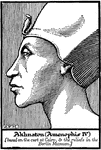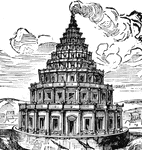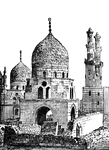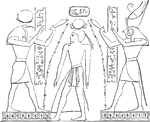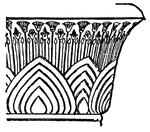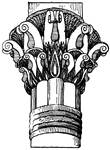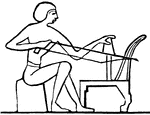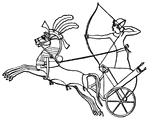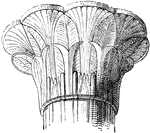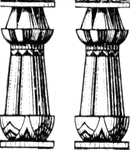
Rock Temple at Abu-Simbel
"The temple, built by Ramses II on the steep face of a cliff overlooking the Nile, has a facade containing…
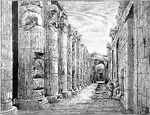
The Temple of Abydos
Built by Seti I and completed by his son Ramses II. The pillars in this temple contain carvings of very…

Egyptian Agriculture
An example of Egyptian agriculture. 1, the reapers; 2, reaper drinking from cup; 3, 4, Gleaners - the…
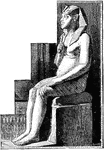
Statue of Amenophis IV
Also known as Akhenaten. Ruled as pharaoh of the Eighteenth Egyptian dynasty for 17 years.
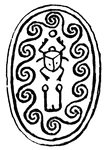
Amulet
The scaraboeus or beetle appears isolated on mummy-cases and elsewhere, as a symbol of creation and…

Anubus
"An Egyptian deity, styled Anepu on hieroglyphic monuments, was, according to mythology, the son of…
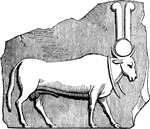
Apis
"The bull worshipped by the ancient Egyptians, who regarded it as a symbol of Osiris, the god of the…
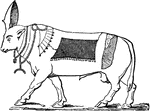
The Bull Apis
Also known as Hapis. In mythology, Apis was a commonly worshipped bull-deity in the Memphis region.
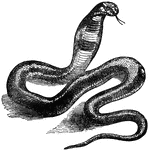
Asp
"A venomous serpent, the name of which has come down from ancient times; the vague descriptions of ancient…
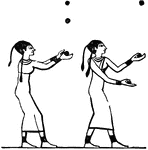
Egyptian Ball Game
"Some of the Egyptian female sports were rather of a hoydenish character, as the game of ball, in one…
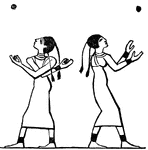
Egyptian Female Ball Game
"Some of the Egyptian female sports were rather of a hoydenish character, as the game of ball, in one…
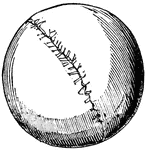
Egyptian Ball
"Some of the Egyptian female sports were rather of a hoydenish character, as the game of ball, in one…

Egyptian Band
"That the Egyptians paid great attention to the study of music and had arrived at a very accurate knowledge…
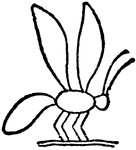
Bee Heiroglyph
"Sign of the king of Lower Egypt; from the coffin of Mykerinos, 1633 B.C." — The Encyclopedia…

Sacred Beetle
"Many of the dung beetles, among which the Sacred Beetle of the Egyptians, Scarabus Aegyptiorum,…
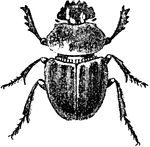
Sacred Beetle
"The Sacred Beetle of Egypt, Ateuchus sacer, somewhat resembles the Dor in form and habits. After depositing…

Egyptian Bellows
"Among the remarkable inventions of a remote era, may be mentioned bellows and siphons. The former were…

Beni Hassan
"Among the figures painted in the very ancient tomb at Beni Hassan, in Egypt, occurs a group of figures…

Egyptian Boatmen Fighting
Brawl among Egyptian boatmen. Carving from the tomb of Ptah-hetep during the Pyramid age.

Two Egyptian Boats
"Two boats moored to the bank of the river by ropes and stakes. In the cabin of one, a man inflicts…

Cairo
The capital city of Egypt. It is located on the banks and islands of the Nile River in the north of…

Capital Types
Figures a and b show the bell-shaped (campaniform) capital. Figure c is a palmiform capital.
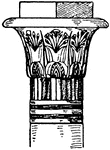
Egyptian Capital
The Egyptian capital is the upper termination of the column with opened papyrus flowers. It is found…
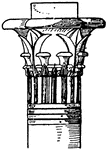
Egyptian Capital
The Egyptian capital is the upper termination of the column with opened papyrus flowers. It is found…
Egyptian Capital
This Egyptian capital is the upper termination of the column with cinctured bundles of papyrus stems.
Egyptian Capital
This Egyptian capital is the upper termination of the column with cinctured bundles of papyrus stems.…

Egyptian chair
"The Egyptian chairs of which we have a great variety of representations, were not inferior in elegance…

Arabian Bas-Relief Circular Panel
The Arabian Bas-relief circular panel is a 14th century design found on a door in Cairo, Egypt.

Cleopatra
(69 B.C.- 30 B.C.) Cleopatra was Queen of Egypt. She had a history with Caesar and went through two…

Egyptian Sarcophagus
A coffin or tomb of stone; a kind of stone chest, generally more or less ornamented for receiving a…
Column
"Columns are largely employed in the architecture of Egyptian temples. They are of various forms." —D'Anvers,…
Column
"Columns are largely employed in the architecture of Egyptian temples. They are of various forms." —D'Anvers,…
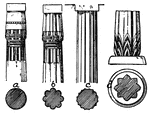
Column Types
Egyptian columns had shafts of three types: a) circular or cylindrical, b) clustered, c) polygonal or…

